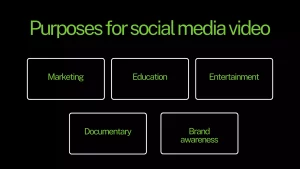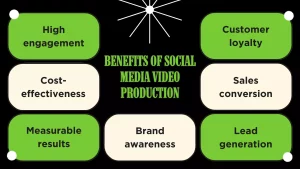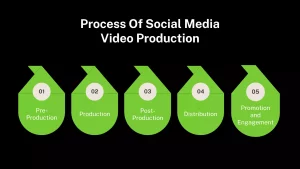What is Social Media Video Production?
Social media videos are another great way to connect with the target audience. You have heard this and absorbed that in your blood?
But why is this so?
In today’s time, people spend quite a lot of time on social media platforms. A report in statista.com, mentioned that a common man spends 151 minutes (about 2 hours and 30 minutes) per day on social media.
Spending such a long time on social media provides brands opportunity to create videos and connect with their target audience.
Let us read more about social media video production.
What Is Social Media Video?
Social media video is video content created to be shared on social media platforms. These videos can be used for a variety of purpose:

- Marketing: Promote products or services.
- Education: Teach people about a particular topic.
- Entertainment: Social media videos can be used to entertain people.
- Documentary: Social media videos can be used to document real-life events or people.
- Brand awareness: Social media videos can build brand awareness and connect with potential customers.
Social media videos are typically short and engaging and designed to be easily shared and consumed on mobile devices. They can be shot with various devices, from smartphones to professional cameras.
Benefits of Social Media Video Production
Here are some of the benefits of using social media video:

- High engagement: Social media videos engages the audience maximum hence it can help you get more views. You get a better chance to interact with the audience.
- Broad reach: Social media videos help you reach a wide audience or a specific audience.
- Cost-effectiveness: Social media videos are cost-effective and it helps to reach a large audience.
- Measurable results: Social media videos can be tracked and measured so you can see how they are performing and make necessary adjustments.
- Brand awareness: Videos can help to build brand awareness and connect with potential customers.
- Lead generation: Videos can generate leads by providing information about your products or services.
- Sales conversion: Videos can convert leads into customers by showing them how your products or services can benefit them.
- Customer loyalty: Videos can help to build customer loyalty by showing them that you care about them and their needs.
- Employee engagement: Videos can engage employees and keep them motivated.
If you want to create engaging and compelling social media content, a video is a great option.
Process Of Social Media Video Production
Social media video production involves several stages to create engaging and compelling content tailored to social media platforms. Here’s a detailed breakdown of the typical process:

- 1. Pre-Production:
- Concept and Planning: Begin by defining the purpose of the video, target audience, and critical message. Create a video concept and outline the script or storyboard.
- Scripting: Write a script or outline that outlines the dialogue, narration, and visuals. Ensure it aligns with the video’s goals and platform requirements.
- Budgeting: Determine the budget for the video, considering costs for equipment, talent, locations, and post-production.
- Casting and Talent: If the video involves actors or presenters, cast suitable talent. Arrange auditions or hire professionals as needed.
- Location and Props: Secure locations, props, and any necessary permits for filming.
- Scheduling: Create a production schedule, specifying shooting days, locations, and the order of scenes.
- Equipment: Gather necessary video and audio equipment, including cameras, microphones, lighting, and accessories.
- Crew: Get together with the production team, including a director, camera operators, sound technicians, and any additional crew members.
- 2. Production:
- a. Shooting: Capture video footage according to the script and storyboard. Ensure proper lighting, framing, and audio recording during the shoot.
- b. Direction: The director guides the actors, manages the crew, and ensures the video adheres to the planned concept.
- c. B-Roll: Capture additional footage or “B-roll” to enhance the storytelling and transitions in post-production.
- 3. Post-Production:
- a. Editing: Review and select the best clips and sequences. Edit the video, adding transitions, effects, and titles. Ensure the video flows smoothly and aligns with the script.
- b. Sound Design: Enhance audio quality by adjusting levels, adding music or sound effects, and ensuring clear voice overs or dialogue.
- c. Color Correction and Grading: Adjust the colour and tone of the video to achieve the desired look and mood.
- d. Graphics and Text: Incorporate graphics, text overlays, and animations to convey information or engage the audience.
- e. Video Length: Optimise the length for the chosen social media platform. Shorter videos perform better on platforms like Instagram and TikTok, while longer content may be suitable for YouTube or Facebook.
- 4. Distribution:
- a. Platform Selection: Choose the appropriate social media platforms for your video content based on your target audience and goals.
- b. Upload: Upload the finalised video to the chosen platforms, following their specific formatting and technical requirements.
- c. Optimization: Add relevant tags, descriptions, and hashtags to improve discoverability. Consider scheduling posts for optimal viewing times.
- 5. Promotion and Engagement:
- a. Engagement: Actively engage with comments and messages from the audience to foster a sense of community and connection.
- b. Paid Promotion: Use paid advertising options on social media platforms to increase visibility and reach a wider audience.
- c. Analytics: Monitor the performance of your video through platform analytics. Evaluate metrics such as views, engagement, shares, and conversions.
- d. Iterate: Use the data and insights from analytics to refine future video content and improve your social media video strategy.
Effective social media video production involves careful planning, skilled execution, and ongoing evaluation to ensure your content resonates with your target audience and achieves your marketing objectives.
Also Read : 5 main types of video used in video production?
Conclusion
Noboru World is a full service video production company that has a dynamic team of experts. The team has skills and know how to follow trends for social media video production.
You can connect with us via email hello[at]noboruworld.com or book a call.
FAQ
What types of videos work best on social media platforms?
Short, engaging, and visually appealing videos perform well. Examples include product demos, how-to guides, behind-the-scenes footage, testimonials, and entertaining or informative content.
How long should my social media videos be?
Video length depends on the platform. Short videos (15-60 seconds) are effective for platforms like Instagram and TikTok. On Facebook and YouTube, longer videos (1-3 minutes or more) may work better for in-depth content.
What equipment do I need for social media video production?
You can start with a smartphone with a good camera, a microphone, and essential lighting. But if you have a professional equipment like DSLR cameras, external microphones, and lighting kits it can help you improve video quality.
How can I make my videos more engaging?
Use eye-catching visuals, clear audio, and captions to engage viewers within the first few seconds. Incorporate storytelling, humour, or emotional appeal to connect with your audience. Use text overlays and graphics to convey key points.
Do I need a script for my social media videos?
Having a script or outline helps maintain a clear message and structure. A script can ensure you convey essential information effectively, even for short videos.
Should I hire professional actors or use in-house talent?
It depends on your budget and goals. Professional actors can provide a polished look using in-house talent, or employees can add authenticity. Choose based on your brand image and the message you want to convey.
How do I optimise my videos for different social media platforms?
Each platform has specific video format and size requirements. Familiarise yourself with these guidelines and ensure your videos are appropriately formatted. Tailor your content to match the audience and style of each platform.



